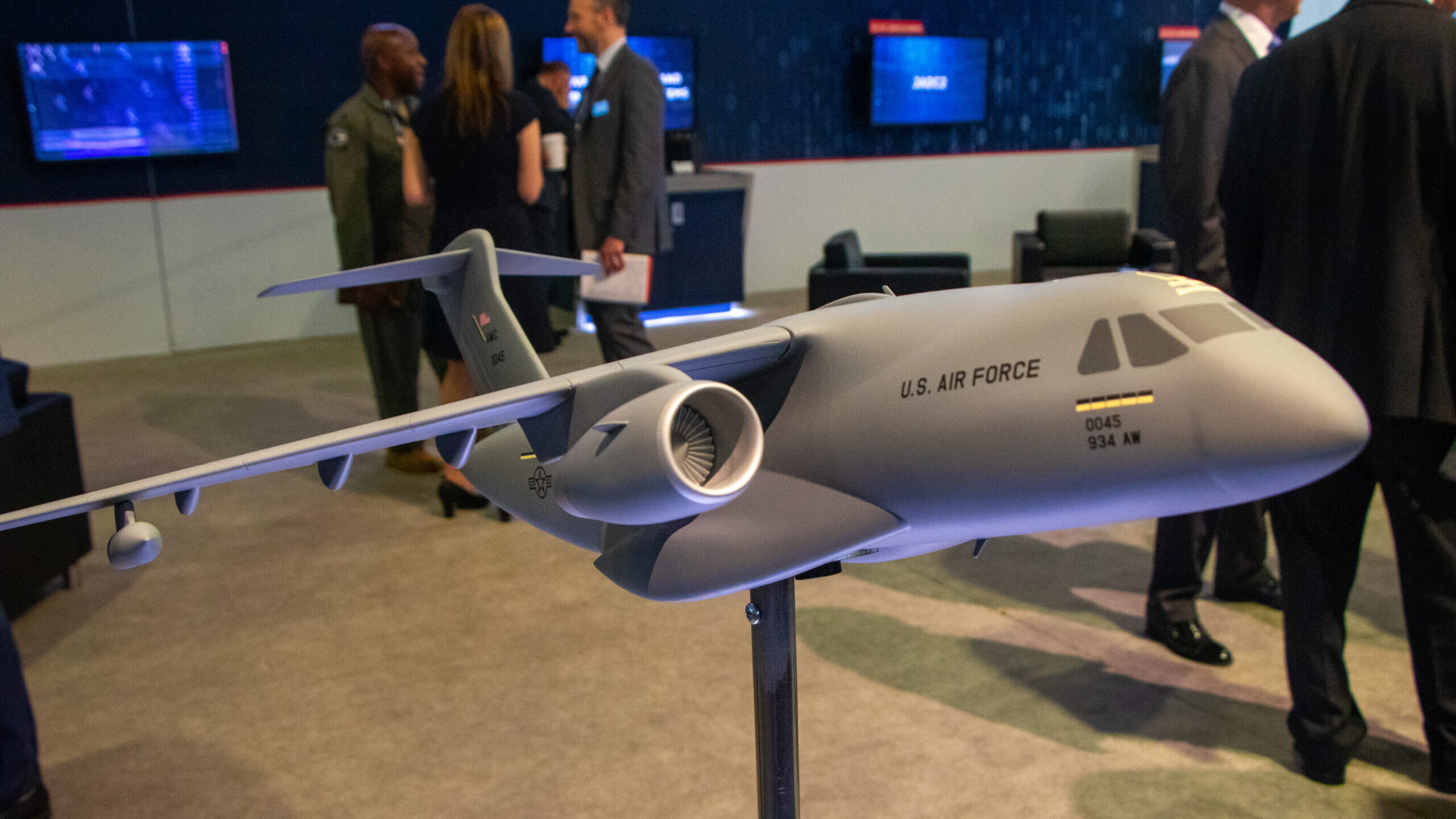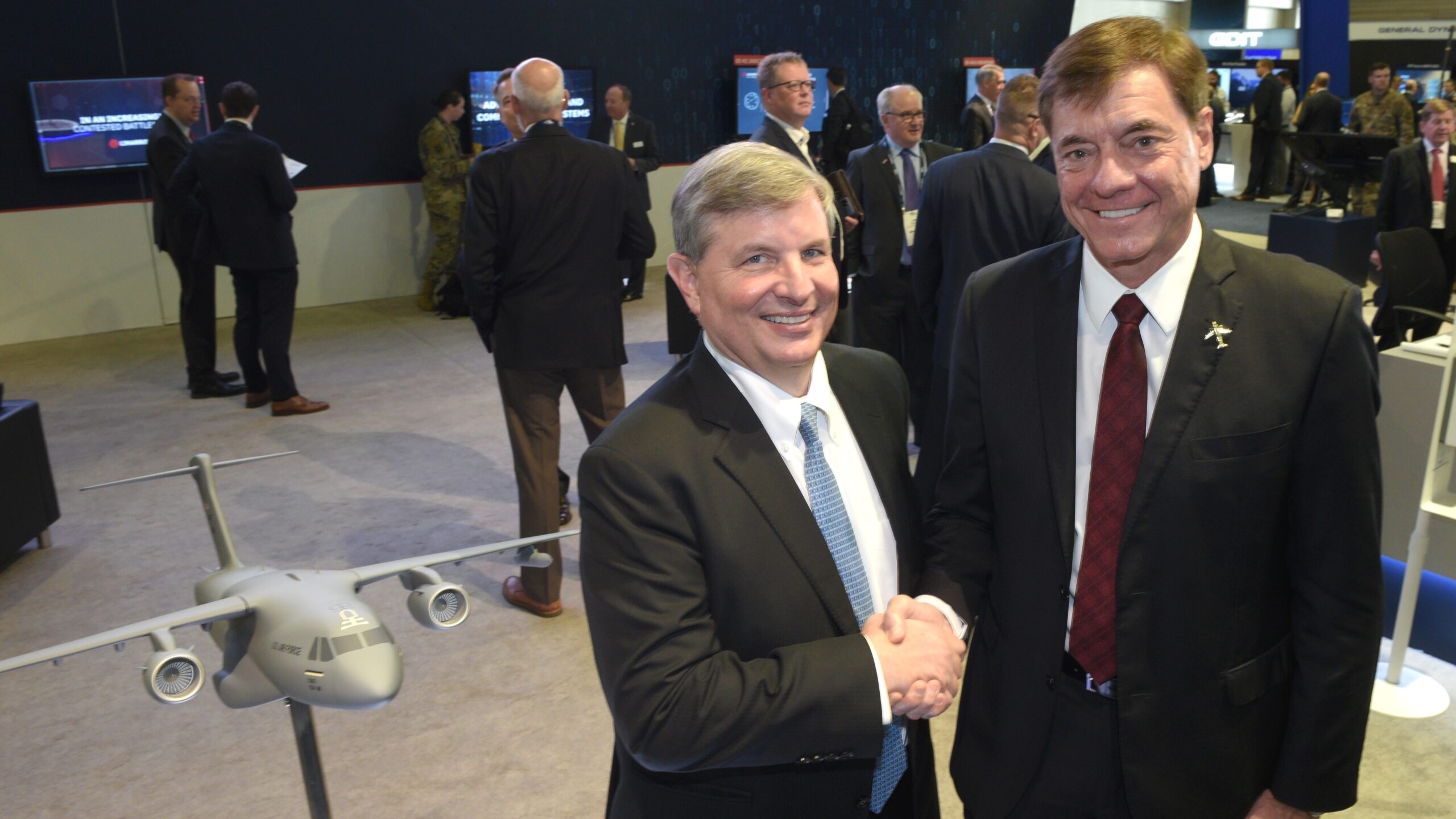
A model of Embraer’s KC-390 with US Air Force markings, on display at the AFA’s Air, Space and Cyber Conference, Sept. 20, 2022. (Justin Katz/Breaking Defense)
WASHINGTON — The last time the US Air Force had an open competition to build a new aerial refueling plane, the fight became so nasty that it became known as “the tanker wars.” Now, with the service currently weighing both a near-term and long-term strategy for new tankers, it’s hard not to wonder if there’s a redux of the brutal lobbying fight on the horizon.
Stepping into that potential battleground last week was the combination of US firm L3Harris Technologies and Brazilian firm Embraer, offering a modified version of the latter’s KC-390 tanker effort, equipped with a boom refueling system. And the strategy for avoiding getting caught up in a fight like the one from a decade ago — and avoiding being tarred as a foreign-made product — seems fairly simple: position the KC-390 as a different class of tanker altogether than what is currently on the market.
“The recurring theme in the military is about disaggregation. So instead of having X amount of large strategic [tankers], which puts a lot of eggs in one basket, you can complement that with these ‘tactical tankers,’ if you will, and they work in conjunction,” Chris Kubasik, CEO at L3Harris, told a group of reporters at last week’s Air and Space Forces Association conference.
“I think the key point that we’ve been telling our customers is, you know, this is complementary, right? I mean, you have these large, very critical strategic tankers carrying twice as much” fuel, he continued. “Fuel is the number one logistical challenge for airplanes, so why would you not want more refueling capability, of different size and shape.”
Positioning the KC-390 as a smaller, “tactical” tanker means that it won’t be competing in the KC-Y program, which has also been referred to as the “bridge tanker.” That effort is supposed to fill potential gaps between when the KC-46 buy is fully online and whatever could come next, dubbed the KC-Z. Already the heavyweights have lined up for KC-Y: Boeing, whose incumbent KC-46A won the fight a decade ago, and a team-up of Lockheed Martin and Airbus, which is offering a version of the latter’s A330 MRTT, branded as the LMXT for domestic consumption. (That’s actually a rematch — the A330 was the runner-up to the KC-46, albeit with Northrop Grumman serving early on as the US contractor.)
The KC-390 team is focused on KC-Z, Kubasik stressed, while acknowledging that the requirements for that contest are still being worked out by the Air Force.
“I’ve been very clear: we don’t want to derail with the Air Force is working on KC-Y, which is strategic,” Kubasik said. “Coming right after that is the KC-Z program. So we’ll be focused on that [analysis of alternatives] and making sure that when that program comes out, this capability, hopefully, will meet the specs to be part of the requirements. So we’re looking at KC-Z.”
Asked during the conference if he had any thoughts on the KC-390 offering, Air Force Material Command head Gen. Duke Richardson said that while the service doesn’t have a requirement for the kind of program being pitched by the two companies, “I would certainly hear them out.”
“You know, one of the things I encourage you to do is, is to me, our relationship with industry should be a push-pull. So sometimes we’ll reach out for things that we think we need, but I always encourage them to push stuff on us that basically, that we don’t know that we need,” Richardson told reporters. “So I haven’t explored it, but we don’t have a requirement for that at this time. But I would, certainly, sit and listen.”

L3Harris CEO Chris Kubasik (L) and Embraer CEO Francisco Gomes Neto pose in front of a KC-390 model during the 2022 AFA Conference. (L3Harris)
Global Opportunity, Global Risk
If there is another competitor in KC-Z — and it seems inevitable there will be, whether or not the Air Force buys into the idea of a tactical vs strategic tanker — then the obvious line of attack on the KC-390 is that it’s really a Brazilian plane, not an American offering. (One potential competitor for the KC-390 is the Lockheed-made KC-130J, a tanker version of the C-130 transport aircraft currently in use by the US Marines.)
That tactic was deployed successfully by Boeing during the first tanker war against European conglomerate Airbus. When the Airbus team originally won the 2008 contract, Boeing launched an all-out legal, lobbying and advertising blitz based heavily on the idea that the plane would not be “American” enough. The effort eventually worked, and during a re-competition, Boeing took an aggressive stance on its pricing that eventually led to a 2011 win for its KC-46A Pegasus design. (Since then, the program has been mired in technical issues, which have crossed $5 billion in overruns.)
Asked about that potential line of attack, Kubasik countered that the current aircraft is “close to 60 percent US components already. And then we’re going to do the final integration in Waco, Texas, where we’ve been doing work for over 70 years modding aircraft, and everything there is additional content. So this will easily be Buy American Act [compliant]. It’s not even going to be close.”
Pushed on whether such an attack might be of concern, Kubasik downplayed the risk..
“Again, I think we’re not competing with anybody else. We’re complementing. You know, I think the two strategics will have their usual back and forth,” he said. “I think this is — I don’t want to say irrelevant to them, I think it’s just like, ‘Okay, this fills in the gap.’”
The upgrades needed to bring the KC-390 up to the standards used by the USAF — the major structural addition of a boom, but also things like protected communications gear — would likely make the tanker attractive to other markets as well. Embraer is currently producing a total of 22 KC-390s for the Brazilian air force, with Portugal, the Netherlands and Hungary also signed on to buy the aircraft.
Both Kubasik and Francisco Gomes Neto, Embraer’s CEO, stressed that they were focusing on the US market and not worrying about other options for now, but, Neto said, “We will analyze case by case. Since we have the technology, why not?”
Added Kubasik, “I think we all been around long enough. You know, once the US procures [something], that opens up the doors, right? … We both have great business internationally. My guess would be we’d go country by country. In some places [Embraer] would lead, in some places [L3Harris] would lead.”






















